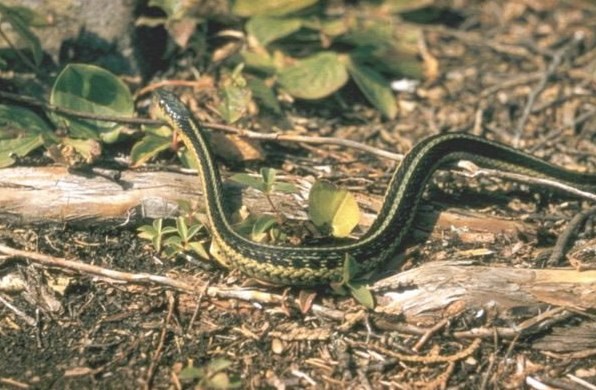
NPS Characteristics The most typical color is yellow, with the dorsal stripe sometimes being darker yellow than the lateral stripes, but the stripes can also be white, blue, greenish or brown. Some snakes have checkered patterns of light rather than lines. Red blotches or a double row of black spots is often present between the stripes. The belly color usually resembles the stripes. The head is wider than the neck and is basically dark colored. The tongue is red but tipped in black till just past where the forks come together. The eyes are round. The scales are keeled. They usually range from 3 to 4 ½ feet in length with the males being smaller. They can live to an age of ten years but average less than half that in the wild. One of their most interesting predator prey relationships is with the extremely toxic Rough-skinned Newt. As the Garter Snakes adapted to be able to handle the toxins, the newt gradually increased their levels of toxin. Through time the levels of toxin in the Newts grew as the resistance of the snakes to the toxins changed. The Newts that did not increase their levels of toxin became prey and did not pass on their genes. The snakes that died from the toxins did not have many young. They are found in urban and suburban areas where there is good cover to hide in. They will also flee into water when threatened. They are diurnal though on hot days they will seek out cooler places. They hibernate through the winter months in most of their range. The hibernacula may hold large numbers of garter snakes as well as other species. More often the emerging female will just check out the pheromones and choose a mate and then head for her summer range and a suitable place to give birth. The males stay by the den to mate with other emerging females. The females however have the ability to store the male’s sperm until it is needed, so she may not mate if she does not find a suitable partner. However sometimes the many suitable males will form a “mating ball” of several males around just one female, and thus several different males may fertilize eggs within the same brood. Youthful Enthusiasm The young eventually figure it out. They are on their own. The males reach sexual maturity in about a year and a half and the females follow suit in two to three years. Maybe this complex system, with its many opportunities for mating, is why the Common Garter Snake is so abundant.
|
Last updated: February 24, 2015
